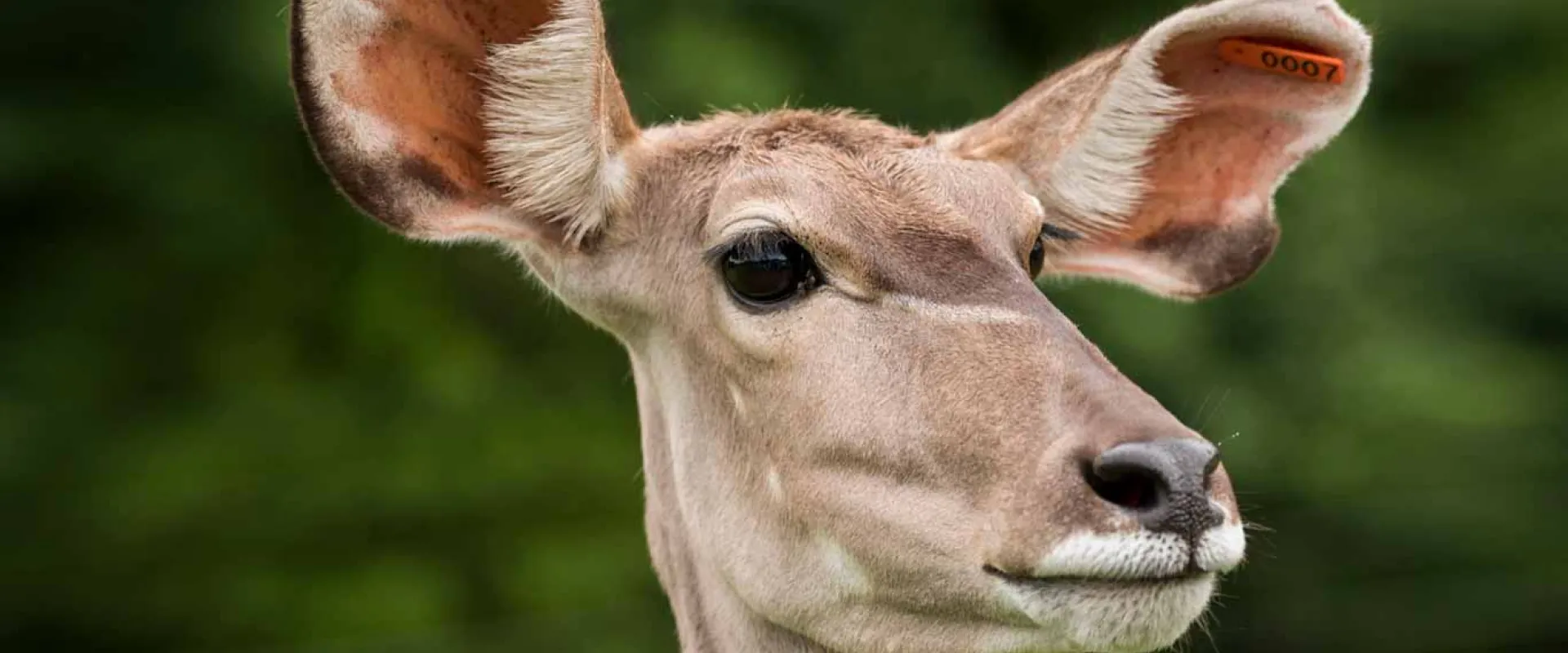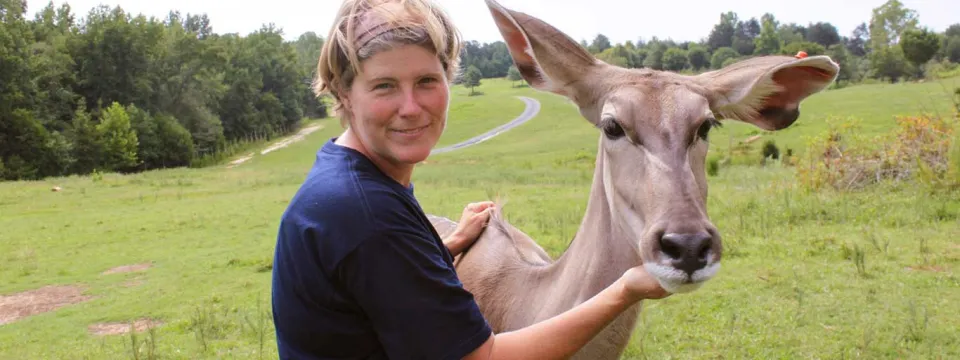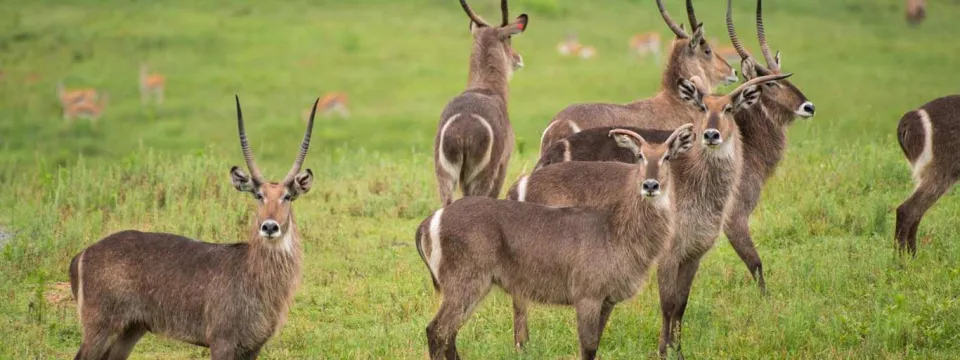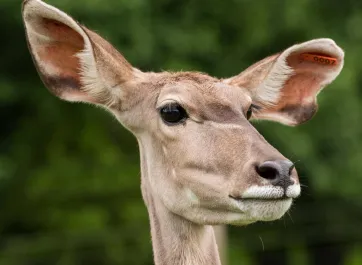Written by Tamara Trull, Zookeeper, North Carolina Zoo
Meet our Kudu herd! We have Summer, Bug, Jelly Bean, Twix, Sundrop, Lulu, Tootsie, and Hubble. All of these ladies were born here at the North Carolina Zoo, except for Lulu and Tootsie who came from the Indianapolis Zoo. I would love to talk about all of them, but there is one in particular that is special to us - Twix! She was born on August 15, 2013 here at the Zoo on the Watani Grasslands.
From the first day, we knew Twix wasn’t going to be like the other kudu. She never received all of her colostrum from her mom, which is the first milk that a calf gets when they nurse. It is very nutritious and has antibodies that help a calf fight infections, which is very important for them to get after they are born. Since she didn’t get any from her mother, the vets decided to do a blood transfusion which would give her the best chance at surviving. We were able to get a blood donation from her half sister, “Ella.” The blood transfusion went very well and she grew to be a beautiful adult kudu.
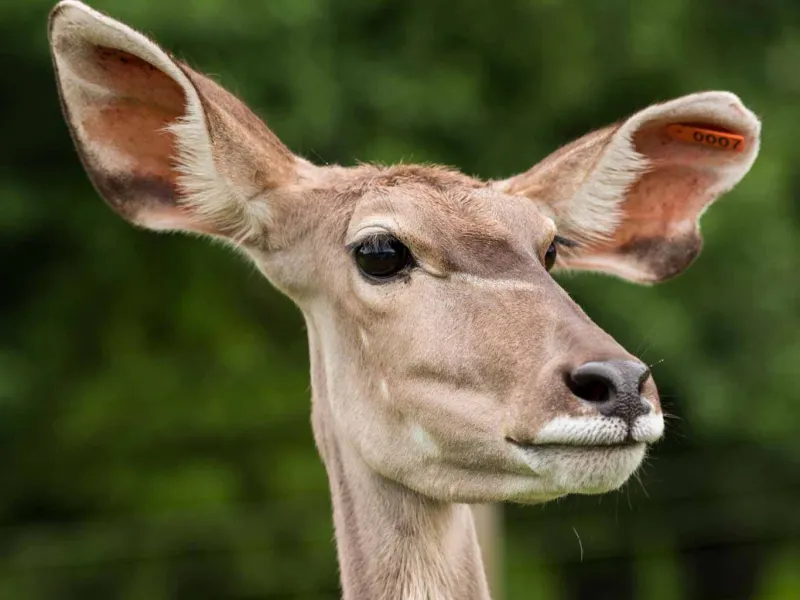
Twix, the kudu
Ever since Twix was a calf, she has been very accustomed to human presence. We used this opportunity to work with her as much as we could on several different training behaviors, with allowing us to touch her being one of them. We wanted to make sure she was comfortable being touched all around her body in case she ever injured herself. She did great with recalling to her name and would come up to the Zoofari bus to meet our guests. She loved being reinforced with treats and the people loved getting to see a kudu up close. The other kudu followed her lead and started approaching the bus as well. She also learned how to target to our fist. This behavior asks Twix to follow our fist and touch her nose to it so that we can ask her to follow us and move in to position for medical examinations. Twix was also trained for ultrasounds, hand injections, hoof trims and blood draws. All these behaviors are valuable to help the veterinarians monitor her health.
In October 2018, Twix developed a limp on her right front foot that didn’t get better with pain medication. The Zoo’s vet team scheduled an anesthetic procedure to get radiographs of her leg, finding there was some soft tissue damage. A few days later, Twix developed a cough, wasn’t eating well or acting quite like herself. Through the trained voluntary blood draw behavior, vets were able to collect blood to assess what was the underlying cause of her symptoms. Twix did great – I couldn’t believe it! The blood work determined that Twix had an infection, so an antibiotic was prescribed. However, a week later without improvement, the vet team advised they needed to get a radiograph of Twix’s lungs, which would require additional training. We began desensitizing getting her used to a radiograph machine and lead aprons, and used the target behavior to teach her to line up to the correct position of the radiograph machine. With much practice, the vet techs were able to get a clear radiograph image.
Unfortunately Twix still wasn’t improving, so another anesthetic procedure was scheduled to get a culture from her lungs. It was determined that she still had an infection in her lungs, which would only be cured through antibiotics administered through a catheter, which was placed in her neck during the procedure. Once she awoke, things didn’t go as planned and Twix tried everything to get the catheter out. While waiting for the culture results to come back, keepers needed to flush the catheter to prevent it from getting blood clots. There was risk of losing her if the catheter clotted, a thought that still tears me up to this day. This was a very stressful time of my life as a keeper. I love this girl and was determined I wasn’t going to give up until we were able to flush the catheter. With the pressure on, we worked with her every minute we could to get her comfortable with having her neck touched again. Through patience and persistence and positive reinforcement, she got more comfortable with the procedure. And after 2 attempts, we were successfully able to flush the catheter and a huge weight was lifted off of our shoulders. Soon the culture results came back and the appropriate antibiotic was administered through this catheter.
Above: Keeper Tamara Trull and one of her favorite kudu - Twix. Seven species of antelope live on the Zoo's Watani Grasslands
Things were looking up – Twix started to eat and act more like herself – she was a champ! Because she had lost weight, our Horticulture Team graciously brought her browse each day. By this time, Twix was getting so spoiled by getting hand-fed, she didn’t even want to eat out of her own tub. That’s when the vet techs came one day with a wand for Twix and dubbed her Princess Twix.
A couple of weeks later vets took some more voluntary radiographs of Twix’s lungs and collected blood. Radiographs and the blood showed that the antibiotics were working and she was on the right track for recovery. After a month and a half passed, her vets cleared her and let her return to the habitat! If it wasn’t for the Grasslands team, vets, vet technicians, and horticulture teams, Twix wouldn’t be here today. If you’re ever on the Zoofari bus, ask the educator to point her out. She has an orange tag on her left ear. You never know, she might even come up to the bus to say “hi.”
Twix and the rest of the herd live on the Zoo's expansive 40-acre Watani Grasslands habitat, along with many other species of antelope including waterbuck and Thompson's gazelles (pictured below)
